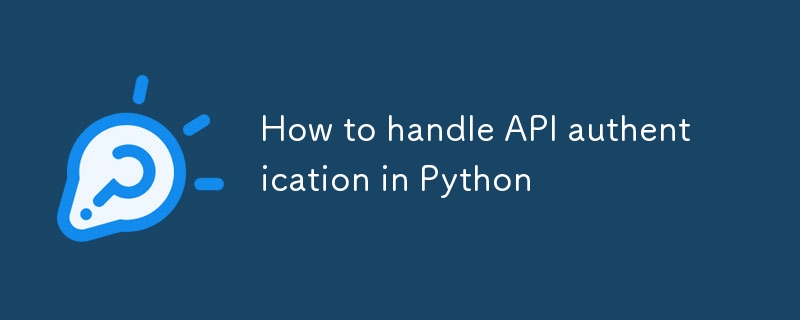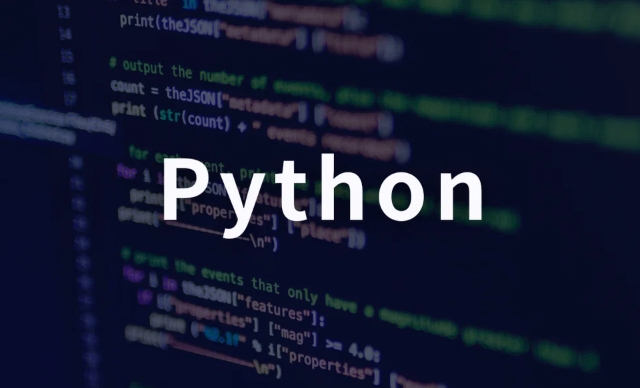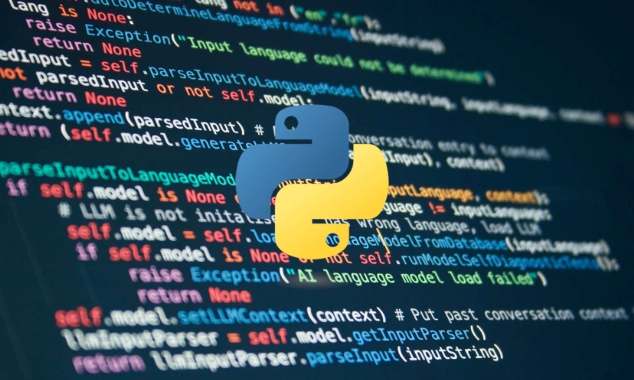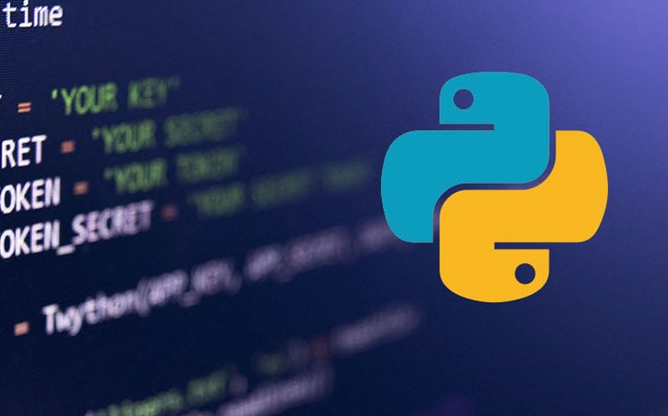How to handle API authentication in Python
The key to handling API authentication is to understand and use the authentication method correctly. 1. API Key is the simplest authentication method, usually placed in the request header or URL parameters; 2. Basic Auth uses username and password for Base64 encoding transmission, suitable for internal systems; 3. OAuth2 needs to obtain the token first through client_id and client_secret, and then bring a Bearer Token in the request header; 4. In order to deal with the token expiration, the token management class can be encapsulated and automatically refreshed the token; in short, selecting the appropriate method according to the document and safely storing the key information is the key.

Handling API authentication is not actually mysterious. The key is to understand the authentication method you use and how to use it correctly in Python. The authentication mechanisms used by different APIs may be different, but the most common methods are: API Key, Basic Auth, OAuth1, and OAuth2. Let’s take a look at how these common methods are handled in Python.

Use API Key to authenticate
Many services verify the request source through a simple API Key, which is usually sent as part of the request headers.
The method is very simple:

- Add
Authorizationfield to the request header, the value isAPI_KEY - Or append
key=your_api_keyto the URL parameter
import requests
headers = {
'Authorization': 'your_api_key_here'
}
response = requests.get('https://api.example.com/data', headers=headers)Some APIs require you to use specific field names in the header, such as
X-API-Key. At this time, you cannot forceAuthorization, you have to see the documentation instructions.
Using Basic Auth
Basic Auth is a relatively basic HTTP authentication method. Usually, the user name and password are combined into a string and then Base64 encoding is passed to the server.

Python's requests library provides built-in support:
import requests
response = requests.get(
'https://api.example.com/data',
auth=('username', 'password')
)This method is suitable for testing or internal system use and is not recommended for public services because credentials are easily intercepted.
Use OAuth2 to get the token and call the API
Now many services use the OAuth2 process to obtain the access token (Token), and then use this token to initiate subsequent requests.
The general process is as follows:
- Apply for token from the authentication server (client_id and client_secret are required)
- Received the returned access_token
- Take
Authorization: Bearer your_token
import requests
# Get Token
data = {
'grant_type': 'client_credentials'
}
auth = ('client_id', 'client_secret')
response = requests.post('https://api.example.com/oauth/token', data=data, auth=auth)
token = response.json()['access_token']
# Use Token to request data headers = {'Authorization': f'Bearer {token}'}
data_response = requests.get('https://api.example.com/data', headers=headers)The implementation details of OAuth2 on different platforms may vary slightly, such as some need to add scope, and some need to specify content-type. Remember to refer to the official documentation.
Handle Token Expiration and Automatic Refresh
Tokens generally have validity periods, and they need to be re-acquisitioned after they expire. If you are writing long-term service (such as background tasks), it is recommended to encapsulate a Token management class.
You can design the logic like this:
- Get the token before the first request
- Save the token and expiration time
- Determine whether the token expires before each request
- If it expires, re-acquire
import time
class TokenManager:
def __init__(self, client_id, client_secret):
self.client_id = client_id
self.client_secret = client_secret
self.token = None
self.expires_at = 0
def get_token(self):
if time.time() >= self.expires_at:
# Simulate requests for new tokens
self.token = 'new_token'
self.expires_at = time.time() 3600 # Assume that one hour expires return self.token After encapsulation, get_token() method can be called uniformly when actually calling the API to avoid frequent manual refresh.
Basically that's it. Although there are a lot of authentication methods, each has a fixed routine. The key is to choose the right method based on the document and pay attention to safely storing the key information.
The above is the detailed content of How to handle API authentication in Python. For more information, please follow other related articles on the PHP Chinese website!

Hot AI Tools

Undress AI Tool
Undress images for free

Undresser.AI Undress
AI-powered app for creating realistic nude photos

AI Clothes Remover
Online AI tool for removing clothes from photos.

Clothoff.io
AI clothes remover

Video Face Swap
Swap faces in any video effortlessly with our completely free AI face swap tool!

Hot Article

Hot Tools

Notepad++7.3.1
Easy-to-use and free code editor

SublimeText3 Chinese version
Chinese version, very easy to use

Zend Studio 13.0.1
Powerful PHP integrated development environment

Dreamweaver CS6
Visual web development tools

SublimeText3 Mac version
God-level code editing software (SublimeText3)

Hot Topics
 1793
1793
 16
16
 1736
1736
 56
56
 1587
1587
 29
29
 267
267
 587
587
 Can a Python class have multiple constructors?
Jul 15, 2025 am 02:54 AM
Can a Python class have multiple constructors?
Jul 15, 2025 am 02:54 AM
Yes,aPythonclasscanhavemultipleconstructorsthroughalternativetechniques.1.Usedefaultargumentsinthe__init__methodtoallowflexibleinitializationwithvaryingnumbersofparameters.2.Defineclassmethodsasalternativeconstructorsforclearerandscalableobjectcreati
 Python for loop range
Jul 14, 2025 am 02:47 AM
Python for loop range
Jul 14, 2025 am 02:47 AM
In Python, using a for loop with the range() function is a common way to control the number of loops. 1. Use when you know the number of loops or need to access elements by index; 2. Range(stop) from 0 to stop-1, range(start,stop) from start to stop-1, range(start,stop) adds step size; 3. Note that range does not contain the end value, and returns iterable objects instead of lists in Python 3; 4. You can convert to a list through list(range()), and use negative step size in reverse order.
 Accessing data from a web API in Python
Jul 16, 2025 am 04:52 AM
Accessing data from a web API in Python
Jul 16, 2025 am 04:52 AM
The key to using Python to call WebAPI to obtain data is to master the basic processes and common tools. 1. Using requests to initiate HTTP requests is the most direct way. Use the get method to obtain the response and use json() to parse the data; 2. For APIs that need authentication, you can add tokens or keys through headers; 3. You need to check the response status code, it is recommended to use response.raise_for_status() to automatically handle exceptions; 4. Facing the paging interface, you can request different pages in turn and add delays to avoid frequency limitations; 5. When processing the returned JSON data, you need to extract information according to the structure, and complex data can be converted to Data
 How to read a JSON file in Python?
Jul 14, 2025 am 02:42 AM
How to read a JSON file in Python?
Jul 14, 2025 am 02:42 AM
Reading JSON files can be implemented in Python through the json module. The specific steps are: use the open() function to open the file, use json.load() to load the content, and the data will be returned in a dictionary or list form; if you process JSON strings, you should use json.loads(). Common problems include file path errors, incorrect JSON format, encoding problems and data type conversion differences. Pay attention to path accuracy, format legality, encoding settings, and mapping of boolean values and null.
 python one line if else
Jul 15, 2025 am 01:38 AM
python one line if else
Jul 15, 2025 am 01:38 AM
Python's onelineifelse is a ternary operator, written as xifconditionelsey, which is used to simplify simple conditional judgment. It can be used for variable assignment, such as status="adult"ifage>=18else"minor"; it can also be used to directly return results in functions, such as defget_status(age):return"adult"ifage>=18else"minor"; although nested use is supported, such as result="A"i
 Python for loop to read file line by line
Jul 14, 2025 am 02:47 AM
Python for loop to read file line by line
Jul 14, 2025 am 02:47 AM
Using a for loop to read files line by line is an efficient way to process large files. 1. The basic usage is to open the file through withopen() and automatically manage the closing. Combined with forlineinfile to traverse each line. line.strip() can remove line breaks and spaces; 2. If you need to record the line number, you can use enumerate(file, start=1) to let the line number start from 1; 3. When processing non-ASCII files, you should specify encoding parameters such as utf-8 to avoid encoding errors. These methods are concise and practical, and are suitable for most text processing scenarios.
 python case-insensitive string compare if
Jul 14, 2025 am 02:53 AM
python case-insensitive string compare if
Jul 14, 2025 am 02:53 AM
The most direct way to make case-insensitive string comparisons in Python is to use .lower() or .upper() to compare. For example: str1.lower()==str2.lower() can determine whether it is equal; secondly, for multilingual text, it is recommended to use a more thorough casefold() method, such as "straß".casefold() will be converted to "strasse", while .lower() may retain specific characters; in addition, it should be avoided to use == comparison directly, unless the case is confirmed to be consistent, it is easy to cause logical errors; finally, when processing user input, database or matching
 How to use the map function in Python
Jul 15, 2025 am 02:52 AM
How to use the map function in Python
Jul 15, 2025 am 02:52 AM
Python's map() function implements efficient data conversion by acting as specified functions on each element of the iterable object in turn. 1. Its basic usage is map(function,iterable), which returns a "lazy load" map object, which is often converted to list() to view results; 2. It is often used with lambda, which is suitable for simple logic, such as converting strings to uppercase; 3. It can be passed in multiple iterable objects, provided that the number of function parameters matches, such as calculating the discounted price and discount; 4. Usage techniques include combining built-in functions to quickly type conversion, handling None situations similar to zip(), and avoiding excessive nesting to affect readability. Mastering map() can make the code more concise and professional





